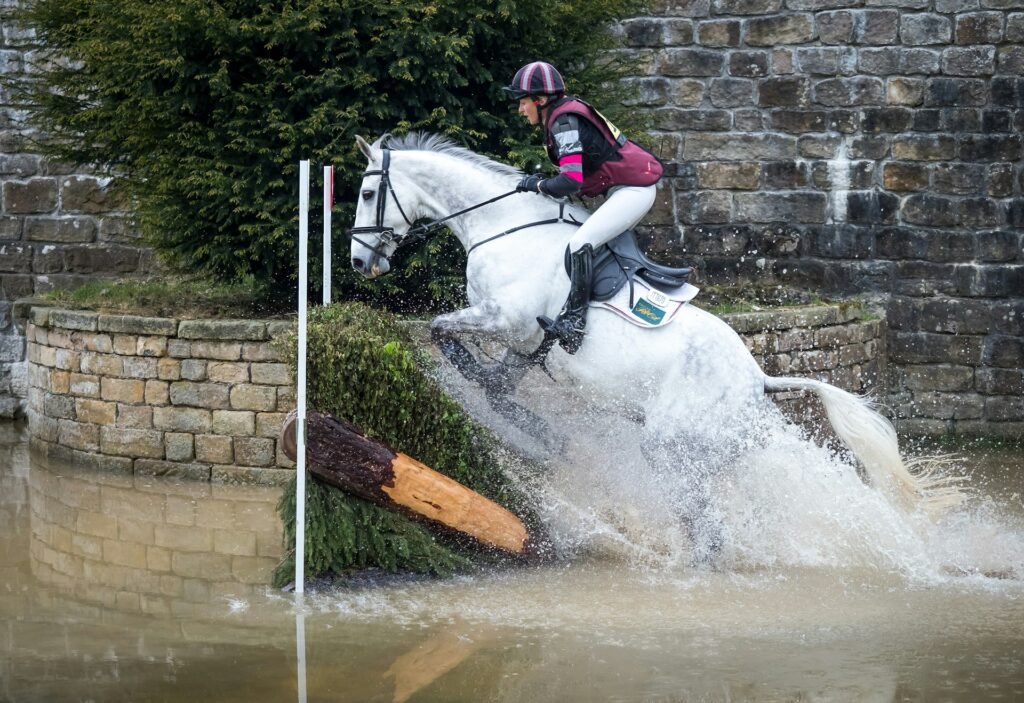Horse jumping showcases the art and athleticism of equestrian sport. This essential element of show jumping and cross-country events features diverse jumps, including verticals, oxers, combinations, and water obstacles. These jumps challenge horses and riders, demanding precision, agility, and trust. Understanding the types and construction of jumps, from solid wood to colorful PVC, highlights their role in testing a horse’s ability to clear heights and distances with grace and skill. Perfecting jumps prepares riders for competitions and enhances the connection between the horse and rider, showcasing the coordination and physical ability essential to horse jumping. Horse jump accessories such as jump cups, poles, and safety flags enhance the versatility and safety of these obstacles, ensuring both practical training sessions and thrilling performances in competitions.
Different Types of Horse Jumps
Various horse jumps are used in competitions and training, each designed to test specific skills and techniques. Some common types include:
- Verticals: Simple, straight-up-and-down jumps test the horse’s ability to jump high. These are often the first types of jumps introduced in training sessions.
- Oxers: Jumps featuring two verticals close together, testing height and distance. They come in various forms, such as square and ascending oxers, each with unique challenges.
- Triple Bars: Three bars set at different heights, challenging the horse’s jumping power and precision. These are commonly used in advanced training sessions to build a horse’s confidence in tackling complex obstacles.
- Water Jumps: Incorporate a water element to test a horse’s ability to clear a vast distance. These jumps can be particularly daunting for beginners and require focused training to ensure both horse and rider are comfortable.
Critical Accessories for Horse Jumps
To set up a comprehensive training course, riders need several vital accessories:
- Cavaletti: These are small, adjustable jumps used for training purposes. They help horses develop rhythm and balance and are crucial for young or inexperienced horses still learning the basics of jumping.
- Jump Cups: Essential for holding the poles at different heights. They allow for easy adjustment of jump heights and ensure that the poles remain securely in place during a jump.
- Ground Lines: Placed before jumps to help horses judge the takeoff point. They significantly aid in timing and accuracy and are particularly useful in teaching young horses the correct approach to a jump.
These accessories are crucial in building a safe and effective training regimen. Utilizing the right equipment helps refine techniques and improve overall performance.
The Importance of Safety in Horse Jumping
Safety in horse jumping is crucial, requiring proper training and equipment use. Riders should wear helmets, body protectors, and appropriate footwear. Horses should be well-trained and comfortable with the course, and the environment should be controlled to minimize distractions. Consistent training and communication with the horse are essential, as are regular veterinary check-ups to prevent underlying issues. Weather conditions should also be considered, and training intensity should be adjusted to avoid strain on the horse.
Maintenance and Care of Horse Jump Equipment
Regular maintenance of jump equipment is vital for safety and longevity. This includes:
- Inspecting for any harm or deterioration. Broken or worn-out equipment can cause serious injuries, making regular inspections essential.
- Cleaning the equipment regularly to prevent dirt and debris buildup. Clean equipment not only lasts longer but also performs better.
- Proper storage to protect against weather damage. Keeping equipment in a dry, sheltered space prolongs its life and ensures it’s always ready for use.
Routine inspections ensure all equipment is in good working condition. Investing time in maintenance can prevent accidents and extend the lifespan of your gear.
Training Tips for Beginners
Starting with horse jumping can be daunting, but it can be gratifying with the right approach. Here are some tips for beginners:
- Build a Strong Foundation: Begin with basic flatwork to develop control and communication with your horse. This foundational work is crucial and sets the stage for success in jumping.
- Start Small: Use lower jumps and gradually increase the height as you and your horse gain confidence. This gradual increase helps build your horse’s muscles and prevents strain.
- Consistent Practice: Regular training sessions help build muscle memory and improve performance. Consistency is critical in any training regimen, and horse jumping is no exception.
- Take Lessons: Work with an experienced trainer who can provide guidance and feedback. An expert can offer valuable insights and correct mistakes you must be aware of.
Following these guidelines ensures a safer and more effective training experience.

